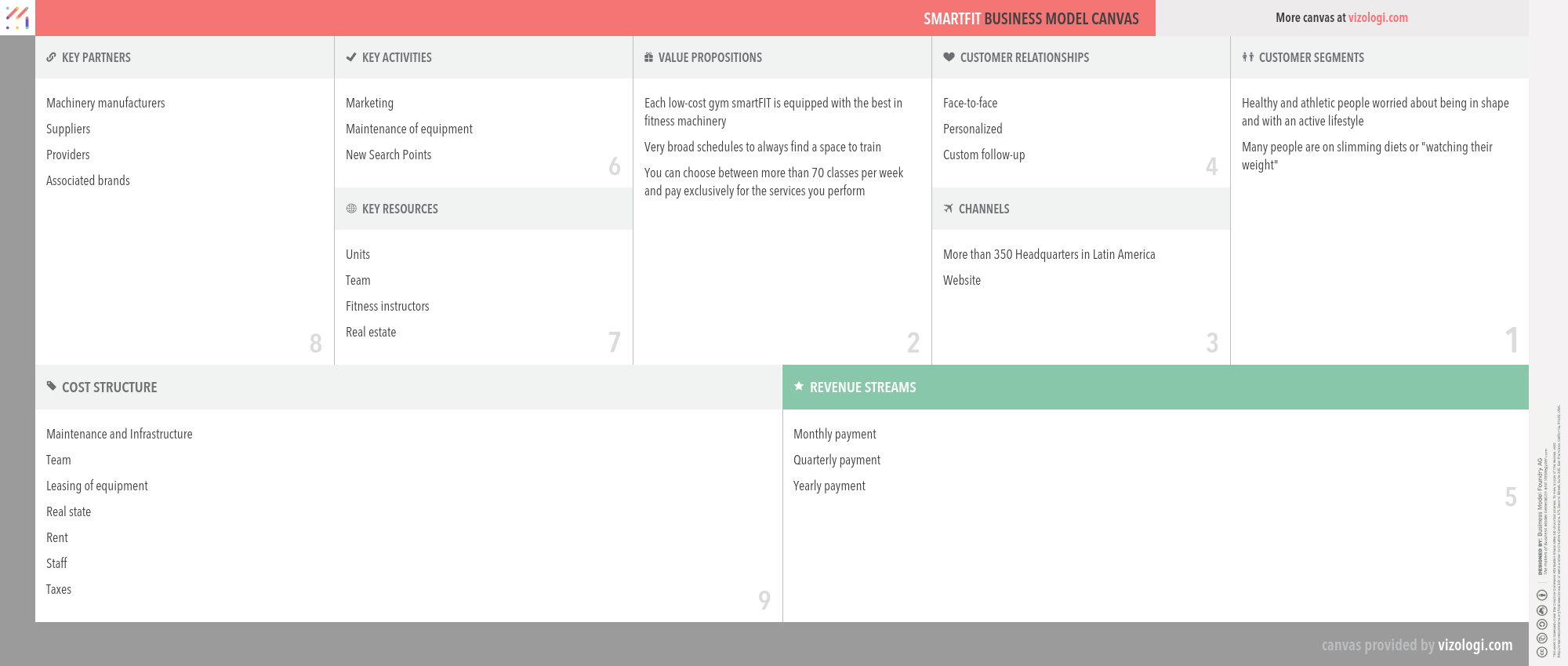Why SmartFit's Business Model is so successful?
Get all the answers 
SmartFit’s Company Overview
Smart Fit arrives in the Dominican Republic as a result of the commercial alliance of two large companies that seek to provide the largest number of people with the opportunity to exercise and be in shape. Grupo Bravo (leading Dominican company in the supermarket sector) and Grupo Bio Ritmo (leading group in the operation of gymnasiums in Latin America), join forces to bring to Dominican Republic their concept of Smart Gym made for you.
www.smartfit.comCountry: Brazil
Foundations date: 2009
Type: Private
Sector: Consumer Services
Categories: Lifestyle
SmartFit’s Customer Needs
Social impact: Self-transcendence
Life changing: self-actualization, affiliation/belonging, motivation
Emotional: attractiveness, rewards me, wellness, therapeutic value, design/aesthetics
Functional: connects, simplifies, integrates, reduces risks, quality, variety, sensory appeal, organizes
SmartFit’s Related Competitors
SmartFit’s Business Operations
Cross-selling:
Cross-selling is a business strategy in which additional services or goods are offered to the primary offering to attract new consumers and retain existing ones. Numerous businesses are increasingly diversifying their product lines with items that have little resemblance to their primary offerings. Walmart is one such example; they used to offer everything but food. They want their stores to function as one-stop shops. Thus, companies mitigate their reliance on particular items and increase overall sustainability by providing other goods and services.
Customer loyalty:
Customer loyalty is a very successful business strategy. It entails giving consumers value that extends beyond the product or service itself. It is often provided through incentive-based programs such as member discounts, coupons, birthday discounts, and points. Today, most businesses have some kind of incentive-based programs, such as American Airlines, which rewards customers with points for each trip they take with them.
Customer relationship:
Due to the high cost of client acquisition, acquiring a sizable wallet share, economies of scale are crucial. Customer relationship management (CRM) is a technique for dealing with a business's interactions with current and prospective customers that aims to analyze data about customers' interactions with a company to improve business relationships with customers, with a particular emphasis on retention, and ultimately to drive sales growth.
Dynamic pricing:
This pattern allows the business to adjust its rates in response to national or regional trends. Dynamic pricing is a pricing technique known as surge pricing, demand pricing, or time-based pricing. In which companies establish variable prices for their goods or services in response to changing market conditions. Companies may adjust their rates based on algorithms that consider rival pricing, supply and demand, and other market variables. Dynamic pricing is widely used in various sectors, including hospitality, travel, entertainment, retail, energy, and public transportation.
Franchising:
A franchise is a license that a business (franchisee) obtains to get access to a business's secret knowledge, procedures, and trademarks to promote a product or provide services under the company's business name. The franchisee typically pays the franchisee an initial startup cost and yearly licensing fees in return for obtaining the franchise.
Low cost:
A pricing strategy in which a business provides a low price in order to drive demand and increase market share. Additionally referred to as a low-price approach. The low-cost model has sparked a revolution in the airline industry. The end-user benefits from low-cost tickets as a result of a revenue strategy that seeks various sources of income. Ryanair was one of the first businesses to embrace this approach.
No frills:
A no frills service or product has been stripped of non-essential elements to keep the price low. Initially, the word frills referred to a kind of cloth embellishment. Something provided free of charge to clients may be a frill - for example, complimentary beverages on airline flights or a radio fitted in a rental vehicle. No-frills companies rely on the premise that by eliminating opulent extras, consumers may benefit from reduced costs. Budget airlines, supermarkets, holidays, and pre-owned cars are examples of everyday goods and services with no-frills branding.
Subscription:
Subscription business models are built on the concept of providing a product or service in exchange for recurring subscription income on a monthly or annual basis. As a result, they place a higher premium on client retention than on customer acquisition. Subscription business models, in essence, concentrate on revenue generation in such a manner that a single client makes repeated payments for extended access to a product or service. Cable television, internet providers, software suppliers, websites (e.g., blogs), business solutions providers, and financial services companies utilize this approach, as do conventional newspapers, periodicals, and academic publications.
Recommended companies based on your search:

